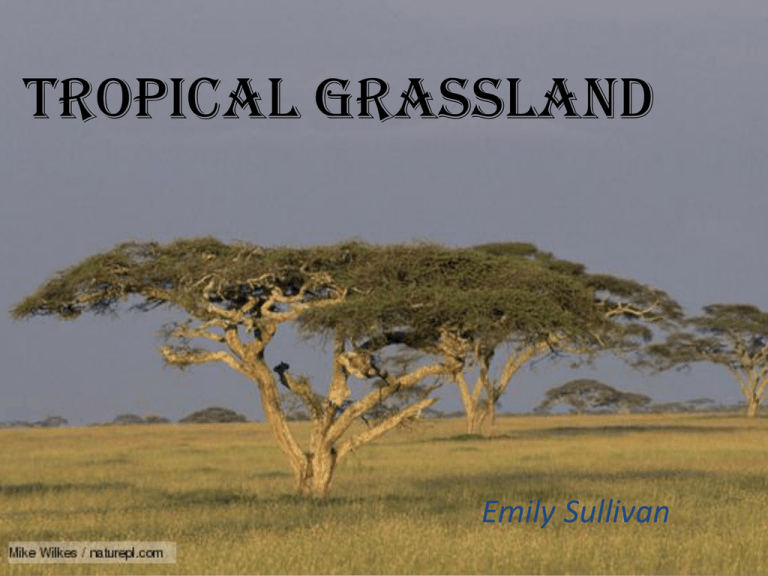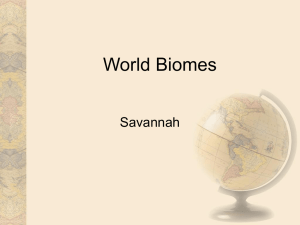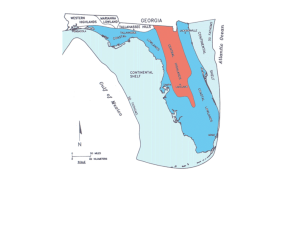Tropical Grassland
advertisement

Tropical Grassland Emily Sullivan Common Names • Savanna – Examples • • • • • East African Savannas Serengeti Plains of Tanzania Brazil’s Cerrado (more diverse, due to location) Northern Australian Savanna Ilanos of Venezuela Typical Food Web Where are Tropical Grasslands Found? Continental Level: • Near the equator, between the Tropic of Cancer and the Tropic of Capricorn – – – – – Africa (general association) Americas (mainly South) India Australia Nepal Where are Tropical Grasslands Found? (ct’d) Regional Level • Between tropical rainforests and desert biome regions – Because there is not enough rain to support a forest, yet are too moist to support a desert Climate of Tropical Grasslands • Characterized by wet and dry seasons (rather than summer vs. winter) • Relatively constant, warm temperatures yearround (around 20°) • High levels of precipitation (~125 cm) from September to March (wet season) • Low levels of precipitation (~0-10cm) from April to August **these can vary per region; some regions experience longer dry periods than wet, and vice versa. Also, statistics depend on the location of the region, in association with the low-sun period. What can you expect to find here? • Animals: – Most animals on tropical savannas have long legs, or are capable of long migrations. – Many burrow underground to avoid heat – Mammals: • Small mammals (i.e. meerkat, hedgehog, shrew, mice, etc.), bats, anteaters, big cats (cheetah, tiger, lion, puma, jaguar, leopard, etc.), hyena, jackals, buffalo, giraffes, gazelle, antelope, hippopotamus, warthog, wallaby, kangaroo, rhino, monkeys, chimps, elephant, etc. – Birds (mostly of prey) • Vultures, cranes, eagles, falcons, ostrich, owl, small birds, – Insects • Gossamer winged butterflies, hummingbird hawk-mouth, • painted lady, desert locust, beetles, termites – Reptiles • lizards, snakes, turtles, crocodiles Animals of the Savanna What can you expect to find here? (ct’d) • Plants – Acacia trees – Baobab trees – Eucalyptus trees – Grasses and sedges – Hat thrower fungus – Orchids – Shrubs Animal Adaptations • Animals – Some hooved animals (like capybara) have adapted to semi aquatic life (wet season) – Browsers and grazers (herbivores)must coexist so have developed distinct niches • Food preferences, grazing heights, time of use, different locations during dry season, etc. • Up to 16 different types of herbivores can coexist in one area – Wide range of herbivores provide carnivores a healthy array of options yielding more variety. – Due to the extreme heat, animals must develop different ways to cool themselves • Ex: Elephants’ large ears to cool off Plant Adaptations • Plants – Have adapted to growing for long periods in standing water (due to wet season), must grow quickly when water is available – Must be able to store water and nutrients in roots for dry season • • • • Some turn brown to limit water loss Small leaves Trees store water in large trunks Long roots – Some have developed drought resistance, fire resistance, browse resistance – Some develop thorns to discourage animals from eating its leaves – Some develop chemical warning signs for other trees (acacia) Human Impacts • In parts of Africa, humans have used the Savanna to graze their cattle and goats – Overgrazing occurs and the grassland is no longer sustainable and turns into a desert. – Desertification • While wild-fires are part of life in savannas, human activity can lead to excess wild-fires – This may destroy habitats, resources, and vegetation • Poaching – Limits biodiversity • Agriculture/Urban Development – Clearing of land Fun Facts! • ~16% of tropical grasslands have been destroyed for agriculture or urban development • The word savanna comes from an Amerind term for “plains” which became Hispanicized after the Spanish Conquest. • Tropical grasslands vary in diversity, with the Brazilian Cerrado being the most diverse – Some species here do not exist anywhere else Sources Miller, G. Tyler, and Scott E. Spoolman. Living in the Environment. 17. Belmont, CA: Brooks/Cole, Cenage Learning, 2012. Print. "Nature Wildlife: Tropical Grassland." BBC. BBC, n.d. Web. 12 Feb 2014. <http://www.bbc.co.uk/nature/habitats/Tropical_and_subtropical_grasslands,_savannas,_and_shrublands>. Schaffner, Brynn. "Savanna." Blue Planet Biomes. Brynn Schaffner, 23 09 2010. Web. 10 Feb 2014. <http://www.blueplanetbiomes.org/savanna.htm>. "Terrestrial Biomes." Bio UTexas . The McGraw-Hill Companies. Web. 12 Feb 2014. <http://www.zo.utexas.edu/faculty/sjasper/images/food_web_savanna.jpg>. Woodward, Susan. "Tropical Savannas." Biomes of the World. Radford University , n.d. Web. 12 Feb 2014. <https://php.radford.edu/~swoodwar/biomes/?page_id=105>. "Grasslands: Terrain of Many." National Geographic: Environment. National Geographic, n.d. Web. 18 Feb 2014. <http://environment.nationalgeographic.com/environment/habitats/grassland-profile/>. "Fact Sheet: Grasslands." Defenders.org. Defenders of Wildlife, n.d. Web. 10 Feb 2014. <http://www.defenders.org/grasslands/tropical-grasslands>. "Biomes." Cotf.edu. Wheeling Jesuit University , 8 Apr 2005. Web. 18 Feb 2014. <http://www.cotf.edu/ete/modules/msese/earthsysflr/savannahP.html>.





